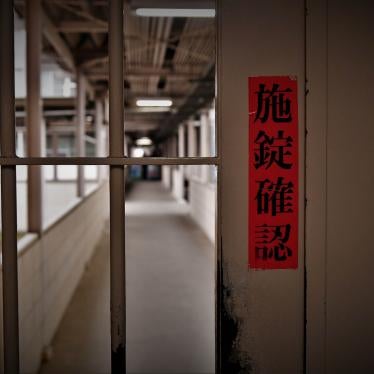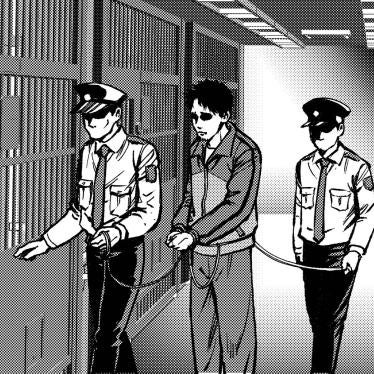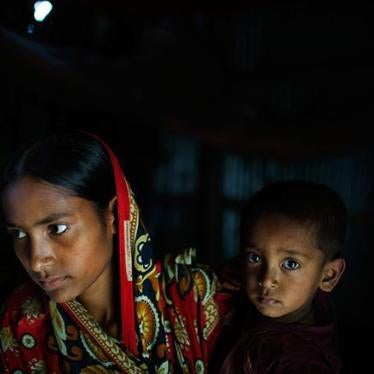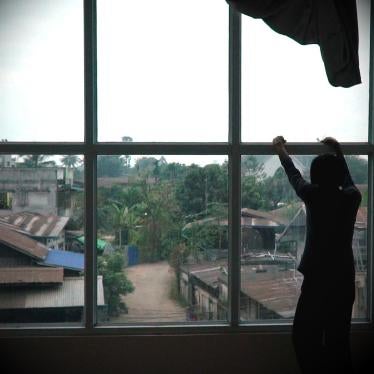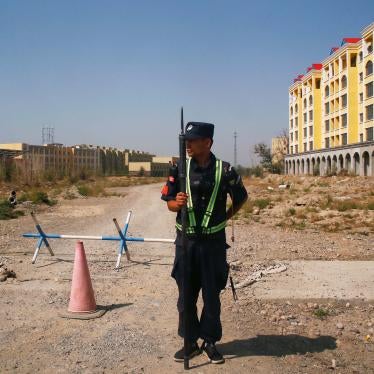(ガザ)- 7月23日~25日にパレスチナ・ガザ地区南部の町クーザで、イスラエル軍が一般市民に発砲して死者が出たいくつかの事件は、武力紛争法に抵触するものと見受けられると、本日ヒューマン・ライツ・ウォッチは述べた。戦闘に参加していない一般市民を狙った意図的な攻撃は戦争犯罪に該当する。
クーザから逃れてきた7人のパレスチナ人がヒューマン・ライツ・ウォッチに詳述したところでは、イスラエル国境に隣接するハンユニス市に安全を求めて避難しようとする人びとが深刻な危険状態にあるという。これら危険には、明らかな民間施設(民用物)に対する再三の砲撃や、必要な医療へのアクセス欠如、戦闘地域から避難する際のイスラエル軍による攻撃の脅威などが含まれる。
ヒューマン・ライツ・ウォッチの中東局局長サラ・リー・ウィットソンは次のように問う。「何日も砲撃を受けた後にイスラエル軍から避難の警告を受けたあげく、致命的な攻撃にさらされているクーザ住民のために、法の裁きが実現するのはいつのことだろうか?」
イスラエル系マスメディアの報道によると、人口約1万人の町クーザは、7月23日にイスラエル軍が地上部隊を展開した際、同軍とパレスチナ武装勢力間の戦闘地域と化した。イスラエル側は7月21日前にクーザ住民に向け避難勧告を出している。武力紛争法は攻撃に対する「実効性のある事前警告」を推奨してはいるものの、それに従わなかった市民を合法的な攻撃対象とみなすことはない。その理由は明らかである。(このような状況のなかでも)無気力や恐怖、行く場所がないなどの理由で避難しない人びとは、多く存在するものだからだ。警告の後も居残る人びとを無視して攻撃する、というこれまでのイスラエル軍のやり方は、到底許されない。
前出のウィットソン局長は、「戦闘から逃れよと警告することは、それに従えなかった住民を標的とする妥当な根拠にはならない。意図的な一般市民への攻撃は戦争犯罪である」と述べる。
ヒューマン・ライツ・ウォッチは7月23日~25日に起きた複数の事件を調査した。いずれについても、クーザを脱出せんとする一般市民にイスラエル軍が発砲した当時、パレスチナ系戦闘員はその場に居合わせず、銃撃戦も起きていなかったと地元住民が証言している。
ある一家の証言によると7月23日朝、クーザのある家に避難のため集まっていた約100人のパレスチナ人にイスラエル軍が退去を命じたという。最初にその家から出たシャヒード・アルナジャーさんは両手を上げていたにもかかわらず、イスラエル兵にあごを撃たれ、重傷を負った。
イスラエル兵は成人男性と15歳以上の少年たちをガザ地区境界フェンス付近に拘禁。証言や報道によると、一部は尋問のためイスラエル側に連行されたという。イスラエル軍は同日、そのほかを小グループに分けて釈放した。ハンユニス市に徒歩で向かった非武装の1グループにイスラエル兵が発砲して、1人が死亡、2人が負傷している。
2人の証言者によると、ほかに2人の年老いた男性が境界フェンス付近で拘禁されていたが、その前にイスラエル軍の爆撃で重傷を負っていたことから、釈放直後に死亡したという。武力紛争法は、負傷した一般市民および戦闘員が最大限に可能な医療を最小限の遅延で受けてしかるべき、と規定している。
7月23日にクーザで起きたほかの事件をめぐっても、イスラエル兵が退去を命じたある一般市民の一団に発砲し、モハメド・アルナジャーさんを殺害したという証言がある。
当該地域に残った市民、避難勧告に従った市民のいずれもが直面する危険を端的に表すのが、7月25日にイスラエルの攻撃で3人が犠牲になった事件だ。証言によると、モタッセム・アルナジャーちゃん(5歳)、カメル・アルナジャーさん(62歳)、サリム・クディさん(推定70歳)は、ほか120人と一緒にある家屋の地下に避難していた際に攻撃で死亡した。クーザで活動する赤十字社の負傷者救援も困難な状況にある。7月25日に赤十字国際委員会(ICRC)が発表したところによると、パレスチナ赤新月社のボランティアが、かの地でイスラエル軍の攻撃により犠牲となった際、彼を救助しようとしたそのほかのボランティアも発砲されたという。武力紛争法は、医療従事者を攻撃対象としてはならない一般市民に定めている。
前述の家屋地下への攻撃を生き延びてハンユニス市に向かった人びとは、白旗を持ち、イスラエル兵に遭遇したときは両手を上げるようにしていた。そのなかの一団にイスラエルのミサイルが直撃していとこが死亡したと、そのとき負傷した人物がヒューマン・ライツ・ウォッチに語った。
ヒューマン・ライツ・ウォッチはハンユニス市に避難してきたクーザ住民に聞き取り調査を行った。これら住民はまだ何百人もの人びとがクーザに取り残されていると考えている。加えて、イスラエルによる集中砲火でがれきに埋もれたままになっている多数の遺体を憂いていた。
今回、クーザでの現地調査は不可能だった。町に続く4本すべての道路が爆弾による巨大な穴のため通行不可能になっており、イスラエル軍が町への出入りを許可するか否かもはっきりしないためだ。
イスラエル政府とハマスなどのパレスチナ武装勢力間で起きたガザの過去の紛争では、国際人道法の重大違反事件がほぼすべて不処罰のまま放置されてきた。パレスチナ自治政府のマフムード・アッバス議長は同領内で全当事者が行った犯罪をめぐる裁判権を、速やかに国際刑事裁判所(ICC)に要請すべきだ。
前出のウィットソン局長は、「たとえすべての兵士が法に従って行動していたとしても、戦争の恐怖は十分に人びとを苦しめる」と述べる。「が、さらに忌まわしいのはイスラエル軍が、一般市民を守る武力紛争法に露骨に違反し、戦争の惨禍を更に悪化させていることだ。」
違法な攻撃の詳細と証言は以下をご覧ください。
Incident 1, Khuza’a, July 23
Akram al-Najjar, 15, said that after Israeli forces began shelling Khuza’a on July 18, his family had “run from house to house seeking shelter.” On the night of July 22, “more than a hundred people had gathered in one house.” At 6 a.m. on July 23, he said, Israeli forces “caught us in the house and told us to come out.” He told Human Rights Watch:
The first one to walk out of the house was Shahid al-Najjar. He had his hands up, but the soldiers shot him. He was shot in the jaw and badly injured, but he survived. Two of the people in the house spoke Hebrew and asked the soldiers why they shot him, and the soldiers said that the rest of the men had to take our clothes off before we walked out. The rest of us came out.
Akram al-Najjar and his grandfather, Mohammed al-Najjar, 75, interviewed separately, said that Israeli soldiers separated the women and men in the group, told the women to leave the area on foot, and allowed boys under age 14 to go with them. The Israeli forces then took the men and older boys to a nearby home, where they put about 50 of them in a room and allowed them to put their clothes back on. Next, the soldiers escorted the group to an alleyway, handcuffed them, and put them in a single-file line, where they waited for several minutes. The soldiers then ordered the group to walk east for about 10 minutes, until they reached another house. Mohammed al-Najjar said:
They put us in a corner. There were a lot of soldiers around, and their weapons. For half an hour, we were standing in the corner, not allowed to speak. Behind the house, there are sand dunes leading to the border [with Israel]. They took us to the sand dunes. They gave the older people water and treated the wounds of the injured. They separated us again, and let the old men and the younger boys go.
He said soldiers had also taken him to the sand dunes where soldiers treated a head wound from a few days earlier when a shell exploded near where he was taking shelter. At around 11 a.m., soldiers again separated the group, according to age, he said. “The men aged 16 to 50 they kept with them, and let the rest of us go,” Mohammed al-Najjar said.
Mohammed and Akram al-Najjar, who left Khuza’a in different groups, said that two elderly men died while trying to leave the area on foot. Mohammed al-Najjar said that one of the men in his group, Abu Wa’el Sanfoura, in his late 60s, “had been burned on the face in the bombardment, and he died from his injuries after we had been released by the Israelis, while we were on the road.” Akram al-Najjar said that his group “had been carrying Suleiman al-Najjar with us, who had been wounded before, during the shelling. He was 70. He died and we left his body behind.”
Akram al-Najjar said that soldiers allowed him to leave the area on the afternoon of July 23, in a separate group of 16 boys and young men, and that the group came under fire after they had reached the Tawhid mosque, in the northwestern part of Khuza’a:
The youngest boy in my group was 14 and the oldest one was 19 years old. We had walked from the dunes and had reached the mosque. We got 50 meters past it, and soldiers started shooting at us. The shooting injured three of us. One of them died. He was shot in the stomach.
He said he did not know the name of the young man who had been killed, but that no one in the group was carrying a weapon. He said there were no Palestinian fighters near his group, and that he did not see or hear any exchanges of fire between Israeli ground forces and Palestinian fighters. After the shooting at the Tawhid mosque, the group ran toward a gas station that “had already been bombed”:
It had two rooms that we took cover in. There were six of us in one room, six in the other, and others were hiding across the street. We were trapped there for three days without food or water, there was shelling all around us. A neighboring house was hit, but there was nothing we could do. We used Suleiman’s phone to call our relatives who had made it out already, and they called the Red Cross, but they couldn’t get coordination [Israeli military permission for safe passage]. Then at 8 a.m. [on July 26] we were told there was a ceasefire, so we started walking, and then we met a family. While we were walking we heard soldiers on a megaphone telling us to go to the school in Abasan. After walking a few kilometers we met up with ambulances there.
Mohammed al-Najjar said he believed that his sons Imad, 42 – Akram’s father – Adnan, 40, and Iyad, 30, were still in Israeli custody. Akram said that he last saw his brother Mohammed, 17, in Israeli custody. An Israeli news website, Walla, and the daily Haaretz, both reported that Israeli forces detained hundreds of Palestinians during military operations in Gaza as of July 24, including 150 on July 23. An unknown number of detainees have been released, according to media reports.
Incident 2, Khuza’a, July 23
In a separate incident on July 23, Hossein al-Najjar, 58, said that he and 50 members of his extended family and neighbors had been trapped in Khuza’a by shelling from July 18 to July 22. He said that Israeli forces shot and killed his cousin, Mohammed al-Najjar, when a group of civilians tried to leave the area on July 23. At dawn on July 23, Israeli forces called his home, and “said we had to get out immediately.” Israeli forces attacked the house soon afterward. “We had only seconds to get out, we weren’t able to carry anything out with us,” al-Najjar said. “Why did they attack us? We had no weapons in the house. We were not fighting them.”
The group was walking northeast, in the direction of Abasan, a town between Khuza’a and Khan Yunis, when they came under small-arms fire, al-Najjar said. “While we were walking out, my cousin Mohammad was shot,” he said. “He was shot with a bullet, not hit by shrapnel. We carried him with us all the way to Abasan.” Al-Najjar did not see where the shot was fired from, but said he saw only Israeli ground forces in the area, not Palestinian fighters. Al-Najjar’s cousin died soon after.
Incident 3, Khuza’a, July 23-25
Kamel Ibrahim al-Najjar, 59, and his daughter-in-law Hakima Abu Reida, 28, interviewed separately, said that Israeli shelling had trapped them in Khuza’a from July 23 until the early morning of July 26. They had called the Red Cross repeatedly to request evacuation, but said they were told that the Israeli military would not agree to coordinate it.
The family had gathered for shelter with about 30 other people when Israeli forces began shelling the area on the night of July 22. Attacks nearby blew out the windows and damaged the building, and the next day, the group moved to a neighbor’s house, where there were already 80 people in the basement. “By that point we were 120 people, 10 men and the rest women and children,” Kamel al-Najjar said.
Abu Reida, who is eight months’ pregnant, told Human Rights Watch:
At 6 or 7 a.m. on [July 24] we heard there was a ceasefire. Our house is in the middle of Khuza’a, and we walked and walked to get to the western end of town, counting on an ambulance to be there. We were getting close but then we saw another group of people up ahead, coming under attack. I don’t know where the shelling came from, but people were saying, “There’s no ceasefire, it’s a trap.” So we turned back. We went to a neighbor’s basement.
Following a night of heavy shelling, after dawn on July 25 an Israeli munition hit the house where the group was taking refuge, without warning. The strike killed Motassem al-Najjar, 5, Kamel al-Najjar, 62, and Salim Qdeih, aged about 70, Abu Reida and al-Najjar said. Abu Reida said:
It was a shock, the blast, it knocked the breath out of me. I had no time to say the [prayer for the dying]. I don’t know why they hit the house, it was random. There was no resistance there, just us. We realized people had been killed, and everyone focused on getting out of the building: grab your children and run before the roof caves in. A nearby house was not as badly damaged, so we went there. I work as a nurse so I started giving first aid.
The attack wounded about 15 people, said Kamel al-Najjar, who was wounded in the eye and head. Abu Reida said she performed first aid on Rawan Ali al-Najjar, 7, who had a deep cut on her head, and Rana Kamel al-Najjar, 23, who was injured in her left leg, and Mohammed Qdeih, 6.
The Israeli military permitted two Palestinian ambulances to enter part of Khuza’a for one hour on July 24 to collect the wounded and recover bodies, according to news reports. On July 25, Israeli forces granted a request by the International Committee of the Red Cross for “coordination” or permission to access Khuza’a for the Palestinian Red Crescent Society (PRCS), so that workers could retrieve the bodies of “a number of people killed during the bombardment in Khuza’a on 23 July,” the UN reported.
However, members of the al-Najjar family said that the Palestinian Red Crescent had not been able to reach them. “We kept calling the Red Cross but they could not get coordination from the army for us to leave, so the women went and made a white flag,” Kamel al-Najjar said.
The ICRC reported that also on July 25, an Israeli attack killed “a Palestinian Red Crescent [Society] volunteer […] as he attempted to treat wounded people in Khuza`a.” The ICRC said, “Other paramedic volunteers who tried to rescue him were also targeted, making it impossible to bring him to hospital in time.”
Kamel al-Najjar and Abu Reida said that their group left at 6 a.m. on July 26 because of the deteriorating condition of the wounded and fears that the house where they were taking refuge would collapse. Abu Reida said:
The only men with us were our husbands and children. We thought we saw resistance next to the house, and we shouted at them to stop fighting and move away, but then we saw that they were Israeli special forces! So we made white flags and started walking, we took random back roads and alleys to avoid soldiers and tanks, but they were everywhere.
They joined another group of people trying to get to safety, 150 people in all. They carried the wounded and a woman with a physical disability for almost a kilometer until they found an abandoned cart, which they then pushed over sandy ground for another kilometer.
Kamel al-Najjar said that the group passed by Israeli military bulldozers and tanks on the outskirts of Abasan al-Kabira: “We were about 50 meters from them, we raised our white flag and continued walking. Everyone was holding their hands up in the air except those carrying the wounded.” The group eventually reached several Red Crescent ambulances. “We gave them the wounded and the weak, because we had gone without food or water for three days,” al-Najjar said. “And we continued walking, to an area that is supposed to be the safe zone. We saw cars and gave them some more of our wounded.”
At that point, he said, an apparent missile strike wounded him and killed his cousin, Shadi Yousef al-Najjar, 22, who was part of the group that had walked from Khuza’a. He was not carrying a weapon, was not a member of an armed group, and there was no fighting in the area at the time, al-Najjar said:
Suddenly I found myself on the ground. Shadi was killed. I put my hand to my side, and started running, calling for an ambulance. I saw cars ahead of me and they took me in, my left leg was broken and shrapnel in my right, but I didn’t even know it, I was running due to adrenaline. They put Shadi in the car too. I was riding with the dead.


